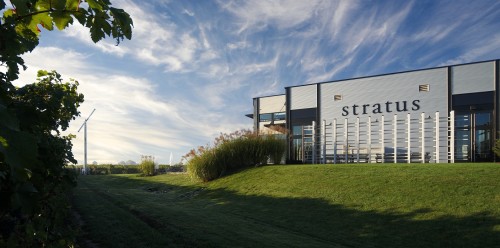 Stunning, that’s how to best describe the top red wines from two of Niagara-on-the-Lake’s grandest estates. Both Stratus Vineyards and Chateau des Charmes have crafted their best wines yet from the magnificent 2012 vintage in Niagara.
Stunning, that’s how to best describe the top red wines from two of Niagara-on-the-Lake’s grandest estates. Both Stratus Vineyards and Chateau des Charmes have crafted their best wines yet from the magnificent 2012 vintage in Niagara.
Their efforts are breathtaking and should stand as a reference point to all those who feel full-bodied, classic, bold red blends with balance can’t be made in Ontario. They certainly can be made here, and they certainly can dazzle you, especially in perfect conditions such as 2012, 2010, 2007 etc., in other words, the warmest vintages.
Knowledge has come a long way with winemakers using past history to coax their Bordeaux grapes — Cabernet Sauvignon, Cabernet Franc, Merlot, Petit Verdot and Malbec — to their peak performance in 2012. That doesn’t always mean leaving them on the vine to ripen past their peak; it sometimes means making picking decisions late in the season that leave room for balance, finesse and finer, less aggressive tannins. It also means making decisions in the vineyard early in the season to manage the canopy so grapes don’t burn out in the heat or shut down completely.
The year 2012 could be Ontario’s turning point, if the reds emerging from this vintage are any indication.
The Stratus Red and Chateau des Charmes Equuleus 2012s have always been benchmark wines for Bordeaux-style reds and they both live up to that reputation after previewing the wines recently.
First, the Stratus Red 2012 (plus the top Stratus White 2102).
Stratus Vineyards
Stratus builds its wine portfolio from a top-down approach.
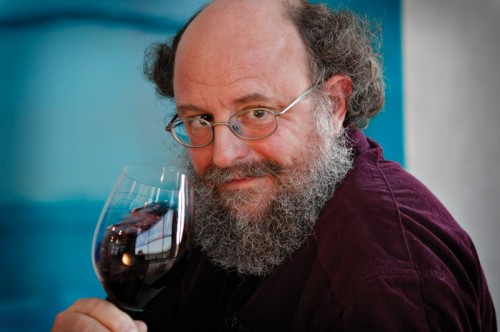 Winemaker J.L. Groux, above, begins with varietals of character, because they’ve been allowed to age for as long as possible in French oak barrels.
Winemaker J.L. Groux, above, begins with varietals of character, because they’ve been allowed to age for as long as possible in French oak barrels.
He then we conducts hundreds of tastings: blind tastings so that the choices are free of preconceptions.
Once the initial selections are made, J.L. and his team work with combinations, continually reevaluating and refining, because — as Stratus maintains — “there is no recipe for assemblage, only a goal.”
Once the blends are established for the two top wines, the rest of the portfolio falls into place.
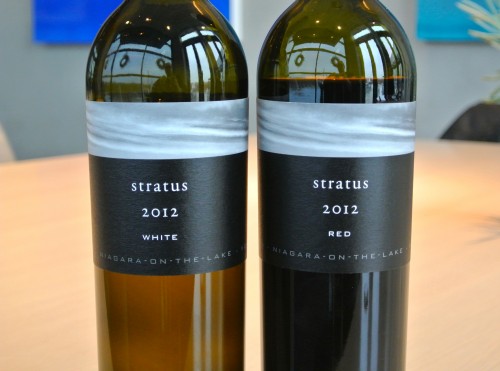 Stratus Red 2012 ($44, late summer release, 94 points) — The newest top wine from Stratus is a remarkable blend of 29% Cabernet Sauvignon, 26% Merlot, 26% Cabernet Franc, 13% Petit Verdot, 3% Malbec, and 3% Tannat that chimes in at a respectable 13.8% alcohol. Off the top, no red wine at Stratus can top this in any vintage, it is the culmination of all the hard work that has gone into the top-down program at the slick and stylish Niagara-on-the-Lake winery. The nose, even in its youth, shows dense and highly aromatic black currants, blackberries, plums, cassis and then oak spices, clove-cinnamon notes and charred vanilla toast. It is so lush, so persistent on the palate, yet it is defined by the richness and purity of the dark layered fruit that is bolstered by lavish spice, grippy tannins and a finessed feel through a long, velvety finish. It is big, no doubt about it, at this stage, but has the power, complexity and grace to reward with 10-20 years in the cellar. A beautiful wine.
Stratus Red 2012 ($44, late summer release, 94 points) — The newest top wine from Stratus is a remarkable blend of 29% Cabernet Sauvignon, 26% Merlot, 26% Cabernet Franc, 13% Petit Verdot, 3% Malbec, and 3% Tannat that chimes in at a respectable 13.8% alcohol. Off the top, no red wine at Stratus can top this in any vintage, it is the culmination of all the hard work that has gone into the top-down program at the slick and stylish Niagara-on-the-Lake winery. The nose, even in its youth, shows dense and highly aromatic black currants, blackberries, plums, cassis and then oak spices, clove-cinnamon notes and charred vanilla toast. It is so lush, so persistent on the palate, yet it is defined by the richness and purity of the dark layered fruit that is bolstered by lavish spice, grippy tannins and a finessed feel through a long, velvety finish. It is big, no doubt about it, at this stage, but has the power, complexity and grace to reward with 10-20 years in the cellar. A beautiful wine.
Stratus White 2012 ($38, debuts at Cuvee later this month, 92 points) — The white assemblage from winemaker J.L. Groux is a blend of 43% Chardonnay, 42% Sauvignon Blanc and 15% Semillon. The Chardonnay was picked early, a departure for Stratus, and the wine was aged for 624 days in French oak, 28% of it new oak. The nose reveals a nice melange of pear, subtle citrus and apple, with creamy-spicy notes that speak to the fine oak aging. The elegance of this blend shows on the palate, a taut and gracious white that reveals its layers slowly; the poached pear, the lanolin, the lemon meringue pie, the minerality and spice. Lovely texture and verve keeps it galloping effortlessly through the finish. Wait for it, cellar a few years.
Chateau des Charmes
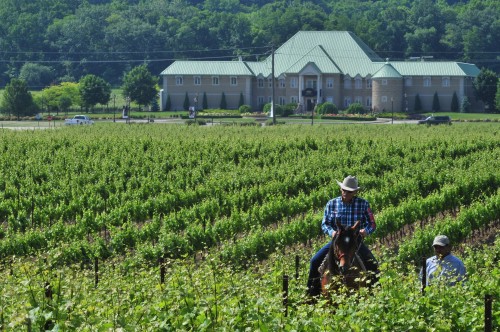 The showcase Paul Bosc Vineyard was planted in 1983 and 1984 and first harvested in 1988. The 60-acre parcel, consisting of Smithville clay-loam and a small pocket of Haldimand clay-loam on the St. Davids Bench, has been the source of the winery’s top wine, Equuleus, since 1998 and prior to that, back to 1988 when it was labelled “Paul Bosc Estate Vineyard.”
The showcase Paul Bosc Vineyard was planted in 1983 and 1984 and first harvested in 1988. The 60-acre parcel, consisting of Smithville clay-loam and a small pocket of Haldimand clay-loam on the St. Davids Bench, has been the source of the winery’s top wine, Equuleus, since 1998 and prior to that, back to 1988 when it was labelled “Paul Bosc Estate Vineyard.”
The blend has essentially remained the same — 50% Cabernet Sauvignon and 25% of both Cabernet Franc and Merlot — and has only been made in the very best vintages, such as 2012.
The wine, prior to 2012, has always been a late bloomer, with a high level of tannins that need time to melt away and integrate. The 2012 takes a different approach, a more approachable blend in its youth and more integrated tannins. It is, to my palate, the best Equuleus to date.
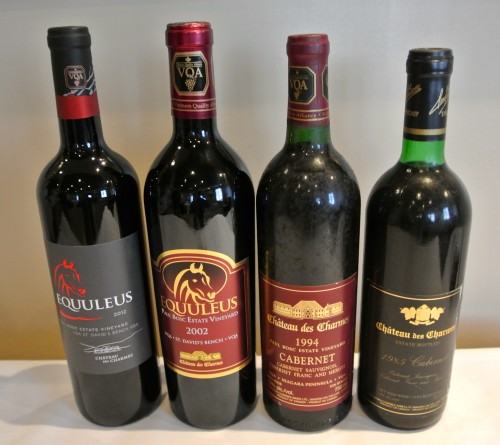 When I tasted this wine with Michele Bosc, I brought along a bottle of the 2002 Equuleus, the 1994 Paul Bosc Estate Cabernet (the predecessor to Equuleus, and a blend of Cab Sauv, Cab Franc and Merlot) and a 1985 Cabernet blend that pre-dates the Paul Bosc vineyard.
When I tasted this wine with Michele Bosc, I brought along a bottle of the 2002 Equuleus, the 1994 Paul Bosc Estate Cabernet (the predecessor to Equuleus, and a blend of Cab Sauv, Cab Franc and Merlot) and a 1985 Cabernet blend that pre-dates the Paul Bosc vineyard.
The Equuleus 2002 was extraordinary and finally fully integrated with less aggressive tannins. The fruit was substantial, bold and alive, with lovely mingling spices and still some freshness and finesse on the finish.
The 1994 Paul Bosc Vineyard Cabernet was gorgeous with mature red fruits, fully integrated spices and soft and smooth through the finish. It has aged much as many of the older Bordeaux vintages I have consumed.
The 1985 Cabernet showed a bit of life, but had faded well beyond its peak and showed a faint corky-musty note, likely a bad bottle.
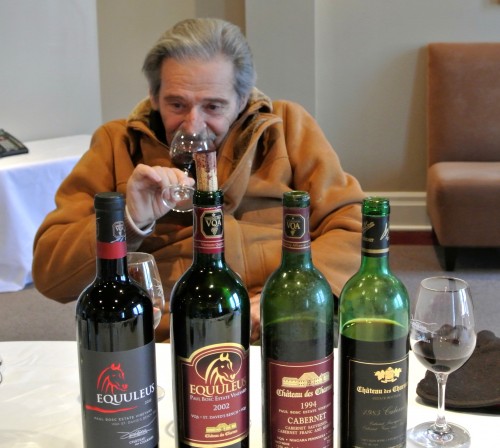 What made my little four-decade vertical tasting at Chateau des Charmes such a thrill was a surprise visit by the winery’s founder, Paul Bosc, who was excited to see the four wines poured together. He was so eager to get tasting he sat down and tasted with us without even taking his jacket off.
What made my little four-decade vertical tasting at Chateau des Charmes such a thrill was a surprise visit by the winery’s founder, Paul Bosc, who was excited to see the four wines poured together. He was so eager to get tasting he sat down and tasted with us without even taking his jacket off.
Bosc still has that wonder and enjoyment you get when tasting something special, even if he was the one who made the wines.
It was a fascinating afternoon with the Bosc family.
Here’s what to expect, plus a couple of other treats coming out soon from Chateau des Charmes.
 Chateau des Charmes Equuleus 2012, Niagara ($40, spring release, 93 points) — The flagship red from this estate is always a blend of 50% Cabernet Sauvignon and 25% of both Cabernet Franc and Merlot that’s made only in the warmest vintages in Niagara. This is the best Equuleus yet, a more modern style that’s approachable now yet will age for 10-20 years. The nose shows rich cherry, a touch of raspberry and then lavish cassis, concentrated black currants and fine oak spices. It is smooth on the palate with generous fruit flavours, fine tannins and integrated spices that echo on the long finish. This was decanted for three hours before tasting at the Chateau.
Chateau des Charmes Equuleus 2012, Niagara ($40, spring release, 93 points) — The flagship red from this estate is always a blend of 50% Cabernet Sauvignon and 25% of both Cabernet Franc and Merlot that’s made only in the warmest vintages in Niagara. This is the best Equuleus yet, a more modern style that’s approachable now yet will age for 10-20 years. The nose shows rich cherry, a touch of raspberry and then lavish cassis, concentrated black currants and fine oak spices. It is smooth on the palate with generous fruit flavours, fine tannins and integrated spices that echo on the long finish. This was decanted for three hours before tasting at the Chateau.
Chateau des Charmes Brut NV ($13 for 375 ml, 90 points) — I’ve always enjoyed this traditionally made bubbly, a classic blend of 50% Chardonnay and 50% Pinot Noir. As a non-vintage sparkling wine it has remained consistent even with this incarnation in a convenient half bottle. It has a vigorous mousse with a crisp nose of fresh lemon, lime, light toast and brioche. There’s a subtle pear note on the palate but dominated by zesty lemon that leads to a toasty-mineral finish. Yummy stuff.
Chateau des Charmes “Old Vines” Riesling 2013 ($17, 89 points) — Riesling was one of the first varietals Paul Bosc planted in 1978 and only the oldest plantings are used in this wine from the St. Davids Bench. The nose is fresh and fragrant with swirling minerality, sweet citrus and green apple notes. In the mouth there is lime zest, apple, a touch of pear, gushing minerality and a subtle sweet petrol note on the finish.






Comment here